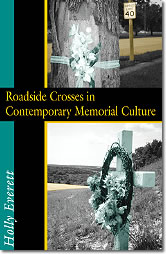

 |
Holly Everett. Roadside Crosses in Contemporary Memorial Culture. Denton, TX: University of North Texas Press, 2002. 160 pages. ISBN: 1574411500. Reviewed by Clayton L. McNearney, for the Journal of Southern Religion.
In a brief 160 pages, accompanied by twenty-five black and white photographs, Holly Everett chauffeurs us past thirty-five roadside memorial sites located in and around Austin, Texas. Her own curiosity about these memorials, her conversations with those who erected and maintain them, and her keen observations make her a well-informed tour guide. Her goal is to help those of us who have observed the recent multiplication of such roadside shrines in North America to think critically and imaginatively about them. While there are some, she says, for whom such shrines "do not register on their cognitive map," and others who are openly hostile toward them, she spends little time traveling down these side roads.
"Everett's fieldwork documents a significant diversity in the people involved in the creation of these memorials." |
The tour she leads quickly becomes a pilgrimage with stops at significant intellectual crossroads where the construction of meaning and material culture converge. The first such intersection is history. Where did the custom of erecting roadside crosses originate? She argues that the phenomenon is a continuation and adaptation of one of the oldest forms of material culture. There is a long history of this practice in Mexico and the southwestern United States, she tells us, but also analogies in several other places (e.g. Greece, England, Germany, Chile, Quebec) or among peoples of the past (e.g. Native Americans and Spanish colonists). Nevertheless, even a cursory glance at the present phenomenon argues that questions of historical origin alone tell us little about their present meaning. Everett's fieldwork documents a significant diversity in the people involved in the creation of these memorials. Although many are erected by Mexican-American Roman Catholics, not all members of this group in the Austin area practice the custom, but some Protestants as well as secular or non-traditionally religious peoples do construct and maintain them. Further, the iconography and design elements of most roadside memorials are too eclectic to be attributable to any singular historical origin.
Thus, it becomes necessary to look elsewhere other than history to make sense out of contemporary roadside memorial practice. The crossroad where such practice meets anthropological analysis proves to be especially fruitful. While Everett demonstrates awareness of the broad range of academic authorities on the exploration of symbol, ritual and folk belief, she finds especially useful the work of Victor Turner on pilgrimage. Under this influence she presents roadside memorials as popularly constructed, permanently liminal sites in which (religious) meaning is constantly negotiated, asserted and preserved. This popular folk-religious practice is a reaction, she says, to the paucity of public ritual response to the facts of death and mourning in modern culture.
Interestingly, Everett finds little from the world of formal theology and organized religion that helps her to understand the ritual construction of these sacred sites. Even the use of the cross, perhaps the most ubiquitous object at these memorials, is often detached from any specific religious beliefs. As one of her informants said to her, "Crosses aren't strictly religious anymore. Everybody wears them, whether they're Christians or not." (p. 112). But this "detachment" to a folklorist like Everett does not just represent an emptying and loss of meaning. Roadside memorials are just the sort of power-filled cultural place where new meanings, new relationships, and a rearrangement of categories are produced.
Roadside memorials result from the often-spontaneous actions of the laity rather than from the direction of the clergy or official church policy. Consequently, the objects and actions of which they are created often display contemporaneousness, flexibility, and unorthodox character. Roadside memorials are often illegal or extra-legal in their placement, but laws and official policy, where these do exist, are often ignored. This "betwixt and between" liminal position adds to their power as folk ritual.
Everett interviewed at some length a few individuals closely involved with creating memorials, and the words of these "informants" – often parents or intimate friends of the deceased – along with Everett's commentary which weaves them into a tighter narrative, are the most valuable strengths of the book. These comments, often unguarded or only minimally self-reflective, provide real insight into the attempts by these individuals to construct a meaningful response to tragic death. They do this through actions, (making, bringing, marking, visiting, maintaining), more than words. Through their eyes and with the aid of Everett, we are able to see those actions that make up this "new" ritual. If we have observed carefully, the next time we pass a memorial along the roadside we might be able to understand it not just as an object with singular, static "meaning," but rather as evidence of the actions of grieving humans trying to present something of the significance of their own experience.
Clayton McNearney, Marshall University
© 1998-2004 by The Journal of Southern Religion. All rights reserved. ISSN 1094-5234